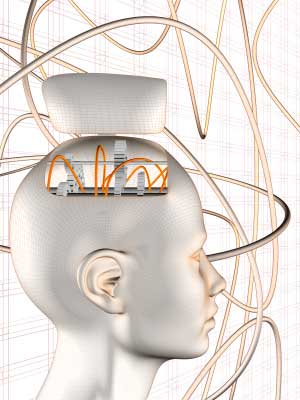Five Pathways to Lasting Behavior Change
We seek to change behavior (stop, start, avoid starting) in order to achieve some outcome such as better health, more savings, superior customer service, killer communications and the like. There are only five pathways for achieving and sustaining a behavior change:
1. Eliminate the need to change behavior but still achieve the outcome. For example, healthy foods well disguised as your favorite snack. I can continue to eat the same food but am now emulating healthier eating habits.
2. Engineer hard stops or gos into the environment that make it impossible to do unwanted behaviors or avoid desired behaviors. For example, no more vending machines in schools.
3. Engineer soft stops or gos into the environment that nudge us towards the preferred behaviors. For example, making healthy choices easier to see and access in the lunch line.
4. Provide guidance or support to individuals as they go through the process of learning the new behaviors from experience. For example, joining Weight Watchers.
5. Observe individuals with advanced skills in self-regulation as they work solo through the process of learning the new behaviors from experience. For example, losing weight on your own. 20-25% of the population have this capacity and more can develop it.
From a cognitive design standpoint we can see how the different pathways leverage insights into the nature of decision-making, self-regulation or control, learning from experience, self efficacy and individual autonomy. For example, the first three pathways (eliminate, hard and soft) focus on changing the environment. As such the need for self-control is minimized and learning is at the stimulus-response level. But ethical issues can emerge as these pathways may impinge on individual liberty and personal choice. They work well in case were there are clear safety concerns and behavior changes are not complex (e.g. healthcare workers washing their hands).
The last two pathways on the other hand (guided, solo) involve the much higher cognitive load associated with self regulation and learning new mental models from experience but are unavoidable when we need to master more complex behavior changes.
I have yet to find a behavior change program that does not follow one or several of these pathways. Even work on the cutting edge seems to fit. Take for example, the recent story in the Wall Street Journal about how food scientists are designing foods to trick our brains into thinking we are full:
“Nestle, one of the world’s largest food companies, hopes to develop new types of foods that, essentially, seek to trick the gut brain. The foods could make people feel full earlier, or stay full longer, in order to curb the desire to eat more. For example, cooking french fries in oil that gets digested more slowly than regular oil could confer a longer-lasting sense of satiety, researchers speculate.”
The gut brain refers to the large neural mass in our gut sometimes called the second brain. Designs that satiate in this way are an example of the first pathway – eliminate. I am redesigning the environment to eliminate the need to change behavior. It happens automatically.
Very interested to hear about behavior change programs or approaches that don’t seem to fit into the five pathways framework.

February 20th, 2011 at 3:07 pm
[...] Cognitive Design Remaking products, services and organizations to fit and enhance the human mind « Five Pathways to Lasting Behavior Change [...]
November 28th, 2011 at 3:08 pm
[...] designing changes to the environment that encourage or require the behaviors as well as one or more pathways to learn them from [...]
October 24th, 2012 at 10:54 pm
hcg…
[...]Cognitive Design » Blog Archive » Five Pathways to Lasting Behavior Change[...]…
January 16th, 2014 at 6:47 am
how do tarot cards work…
Cognitive Design » Blog Archive » Five Pathways to Lasting Behavior Change…
January 16th, 2014 at 11:53 am
GC 180 XT REview…
Cognitive Design » Blog Archive » Five Pathways to Lasting Behavior Change…
February 24th, 2014 at 10:12 am
Garcinia Slendera Reviews…
Cognitive Design » Blog Archive » Five Pathways to Lasting Behavior Change…
February 26th, 2014 at 3:58 am
Http://Riceandbeansmeetscollardgreens.Com/Profile_Info.Php?ID=117573…
Cognitive Design » Blog Archive » Five Pathways to Lasting Behavior Change…
February 26th, 2014 at 12:54 pm
Garciniacambogiafit1300.net…
Cognitive Design » Blog Archive » Five Pathways to Lasting Behavior Change…
February 27th, 2014 at 1:03 pm
garcinia cambogia where to buy…
Cognitive Design » Blog Archive » Five Pathways to Lasting Behavior Change…
February 27th, 2014 at 7:48 pm
http://www.smtt.co.kr/…
Cognitive Design » Blog Archive » Five Pathways to Lasting Behavior Change…
February 28th, 2014 at 3:54 am
Garcinia cambogia dosage…
Cognitive Design » Blog Archive » Five Pathways to Lasting Behavior Change…
February 28th, 2014 at 2:48 pm
Garcinia select and Zyloslim…
Cognitive Design » Blog Archive » Five Pathways to Lasting Behavior Change…
December 11th, 2014 at 9:49 am
cheap mulberry handbags…
Brian Me dealing with small business owners through N . ANAVA and would like to cheap mulberry handbags use your artwork during my posts to cheap mulberry handbagsgether. It is a very effective just one webpage over view on the complex Internet communi…